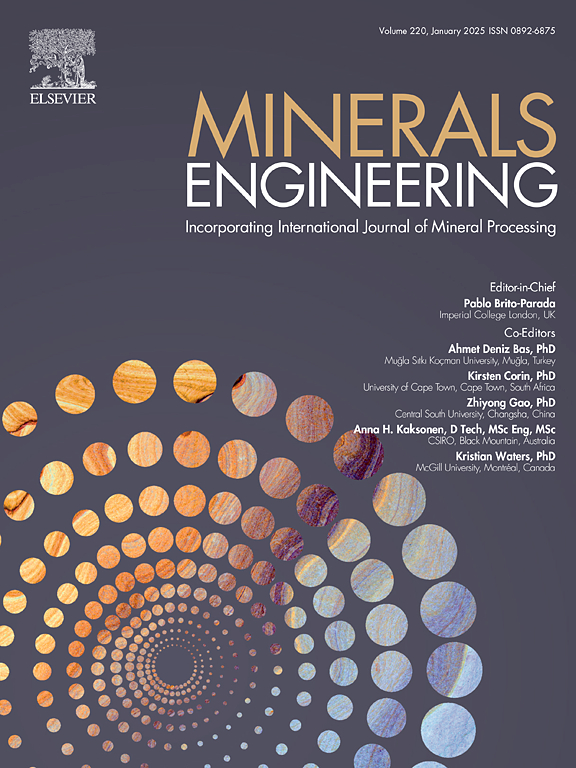Behaviour of the critical elements As, Bi, In, Sb, and Te during processing of a skarn ore: A case study of the Ruwai Zn-Pb-Ag Deposit, Central Kalimantan, Indonesia
IF 4.9
2区 工程技术
Q1 ENGINEERING, CHEMICAL
引用次数: 0
Abstract
Advancements in modern technology are causing a rapid increase in the consumption of critical elements. Many of these elements are obtained as by-products from the extraction and processing of other raw materials. Yet, limited information is available on their concentrations in primary ores, behaviour during ore processing, and availability to the global economy. This study analysed ores and mineral processing samples from the Ruwai Zn-Pb-Ag skarn deposit to constrain the process behaviours of the critical elements As, Bi, In, Sb, and Te, alongside Ag and Cd, through mass-balancing.
Bismuth and Te primarily report to the Pb concentrates at rates of 79–91 %, and 59–77 %, respectively, with losses to tailings below ∼20 % for Bi, and ∼30 % for Te. Antimony recovery to the Pb concentrate is lower (34–52 %), with notable losses to tailings (45–62 %). Indium preferentially reports to the Zn concentrates at rates of 61–84 %, with 14–33 % lost to tailings. By contrast, As is mostly lost to the tailings (77–86 %), with low recoveries in both the Pb and Zn concentrates (5–15 %). Silver and Cd show high recoveries (>76 %) to either the Pb or Zn concentrates. The similar behaviours of Ag, Bi, Sb, and Te to Pb, and Cd and In to Zn, suggest that these elements are either hosted by galena or sphalerite, or by minerals that behave like galena and sphalerite during the flotation process.
The results of this study have major implications for the estimation of critical-element mass flows worldwide, providing the first detailed mass-balance data for As, Bi, In, Sb, and Te from a Zn-Pb-Ag skarn deposit.
矽卡岩矿石加工过程中关键元素As、Bi、In、Sb和Te的行为:以印尼加里曼丹中部Ruwai锌铅银矿床为例
现代技术的进步导致关键要素的消费迅速增加。这些元素中的许多都是作为其他原材料的提取和加工的副产品获得的。然而,关于它们在原生矿石中的浓度、矿石加工过程中的行为以及对全球经济的可利用性的资料有限。本研究分析了如外锌铅银矽卡岩矿床的矿石和选矿样品,通过质量平衡来约束关键元素As、Bi、In、Sb和Te以及Ag和Cd的过程行为。铋和Te主要以79 - 91%和59 - 77%的比率分别向Pb精矿报告,Bi和Te在尾矿中的损失分别低于~ 20%和~ 30%。铅精矿锑回收率较低(34 ~ 52%),尾矿锑损失显著(45 ~ 62%)。铟以61 ~ 84%的比例优先出现在锌精矿中,14 ~ 33%的比例流失到尾矿中。砷主要在尾矿中流失(77 ~ 86%),铅、锌精矿中砷的回收率均较低(5 ~ 15%)。银和镉在铅锌精矿中均有较高的回收率(76%)。Ag、Bi、Sb和Te与Pb的相似行为,Cd和In与Zn的相似行为表明,这些元素要么是由方铅矿或闪锌矿承载的,要么是由在浮选过程中表现为方铅矿和闪锌矿的矿物承载的。本研究的结果对全球临界元素质量流的估计具有重要意义,并首次提供了来自Zn-Pb-Ag夕卡岩矿床的As, Bi, In, Sb和Te的详细质量平衡数据。
本文章由计算机程序翻译,如有差异,请以英文原文为准。
求助全文
约1分钟内获得全文
求助全文
来源期刊

Minerals Engineering
工程技术-工程:化工
CiteScore
8.70
自引率
18.80%
发文量
519
审稿时长
81 days
期刊介绍:
The purpose of the journal is to provide for the rapid publication of topical papers featuring the latest developments in the allied fields of mineral processing and extractive metallurgy. Its wide ranging coverage of research and practical (operating) topics includes physical separation methods, such as comminution, flotation concentration and dewatering, chemical methods such as bio-, hydro-, and electro-metallurgy, analytical techniques, process control, simulation and instrumentation, and mineralogical aspects of processing. Environmental issues, particularly those pertaining to sustainable development, will also be strongly covered.
 求助内容:
求助内容: 应助结果提醒方式:
应助结果提醒方式:


